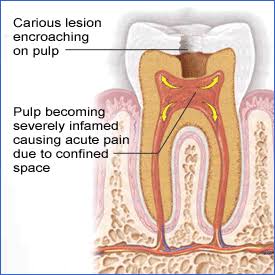
It is a persistent inflammatory condition of the pulp, which may be symptomatic or asymptomatic and is caused by a noxious stimulus.
Causes :-
It is by bacterial involvement of the pulp through caries, although many clinical factors, chemical, thermal or mechanical injury may also be the cause.
Clinical features :-
In early stages of irreversible pulpitis, a paroxysm of pain may be caused by the following: sudden temperature changes like cold, sweet and acid foodstuffs.
The pain often continues when the cause has been removed and it may come and go spontaneously.
Pain is sharp, piercing or shooting and is generally severe. It may be intermittent or continuous, depending on the degree of pulpal involvement and depending on whether it is related to an external stimulus.
The patient may also state that bending over or lying down, i.e. change of position, exacerbates the pain which is due to change in intrapulpal pressure.
Patient may complain of pain referred to adjacent teeth to the temple or sinuses when an upper posterior tooth is involved, or to the angle, when lower posterior tooth is affected.
In later stages, pain is more severe and is generally described as boring, gnawing or throbbing or as if tooth is under constant pressure.
Patient is often awake at night due to pain. Pain is increased by heat and is sometimes relieved by cold, although continued cold may intensify the pain.
Histopathological features :-
. As caries penetrates the dentin it causes a chronic inflammatory response. If the caries is not removed, the inflammatory changes in the pulp will increase in severity as the decay approaches the pulp.
The postcapillary venules become congested and affect the circulation within the pulp, causing pathologic changes such as necrosis.
These necrotic areas attract polymorphonuclear leukocytes by chemotaxis and start an acute inflammatory reaction.
After phagocytosis, the polymorphonuclear leukocytes, which have a short lifespan, die and release lysosomal enzymes. The lysosomal enzymes lyse some of the pulpal stroma and together with the cellular debris of the dead polymorphonuclear leukocytes form purulent exudates (pus).
The inflammatory reaction produces micro-abscess (acute pulpitis). The pulp trying to protect itself walls off the areas of the micro-abscess with fibrous connective tissue .
Clinical differences between reversible and irreversible pulpitis :-
⚫ The pain of irreversible pulpitis is more severe and lasts longer.
⚫ In reversible pulpitis, the cause of pain is generally traceable to a stimulus such as cold water or air whereas in irreversible pulpitis, the pain may come without any apparent stimulus.
Management :-
Complete removal of the pulp or pulpectomy and placement of an intracanal medicament to act as a disinfectant or obtundent such a cresatin, eugenol or formacresol.
Prognosis :-
The prognosis of the tooth is favorable, if the pulp is removed.